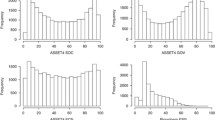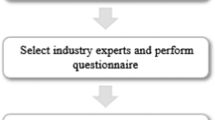Abstract
A common problem in real-world DEA applications is that all inputs and outputs may not be equally relevant to the organizations analysed and their stakeholders. In many cases, one is also faced with a data set where the decision-making units do not clearly outnumber the quantity of inputs and outputs. This study reports an application where DEA embellished with weight restrictions is used to analyse the efficiency of public organizations to overcome the above-mentioned problems. Whereas there are numerous documented applications of weight-restricted DEA in the literature, the process of defining the actual weight restrictions is seldom described. However, that part — defining the actual weights restrictions based on price, preference or value information — is the most difficult step involved in using the weight-restricted DEA. Comparing various weight restriction schemes with real data suggests that the ability to consider and include preference information in DEA adds important insights into the analysis.


Similar content being viewed by others
References
Charnes A, Cooper WW and Rhodes E (1978). Measuring efficiency of decision making units. Eur J Opl Res 2: 429–444.
Allen R, Athanassopoulos A, Dyson RG and Thanassoulis E (1997). Weights restrictions and value judgements in data envelopment analysis: evolution, development and future directions. Ann Opn Res 73: 13–34.
Pedraja-Chaparro F, Salinas-Jimenez J and Smith P (1997). On the role of weight restrictions in Data Envelopment Analysis. J Prod Anal 8: 215–230.
Roll Y and Golany B (1993). Alternate methods of treating factor weights in DEA. Omega 21: 99–109.
Seiford LM (1996). Data envelopment analysis: the evolution of the state of the art (1978–1995). J Prod Anal 7: 99–137.
Kao C and Yang YC (1991). Measuring the efficiency of forest management. For Sci 37: 1239–1252.
Kao C and Yang YC (1992). Reorganization of forest districts via efficiency measurement. Eur J Opl Res 58: 356–362.
Kao C (1998). Measuring the efficiency of forest districts with multiple working circles. J Opl Res Soc 49: 583–590.
Kao C (2000). Measuring the performance improvement of Taiwan forests after reorganization. For Sci 46: 577–584.
Kao C, Chang P and Hwang SN (1993). Data envelopment analysis in measuring the efficiency of forest management. J Environ Mngt 38: 73–83.
Viitala EJ and Hänninen H (1998). Measuring the efficiency of public forestry organizations. For Sci 44: 298–307.
Bogetoft P, Thorsen BJ and Strange N (2003). Efficiency and merger gains in the Danish forestry extension service. For Sci 49: 585–595.
Dyson RG and Thanassoulis E (1988). Reducing weight flexibility in data envelopment analysis. J Opl Res Soc 39: 563–576.
Roll Y, Cook WD and Golany B (1991). Controlling factor weights in data envelopment analysis. IIE Trans 23: 2–9.
Golany B (1988). A note on including ordinal relations among multipliers in data envelopment analysis. Mngt Sci 34: 1029–1033.
Ali AI, Cook WD and Seiford LM (1991). Strict vs. weak ordinal relations for multipliers in data envelopment analysis. Mngt Sci 37: 733–738.
Thompson RG, Singleton Jr. FR, Thrall RM and Smith BA (1986). Comparative site evaluation for locating a high-energy physics lab in Texas. Interfaces 16 (6): 35–49.
Thompson RG, Langemeier LM, Lee CT, Lee E and Thrall RM (1990). The role of multiplier bounds in efficiency analysis with application to Kansas farming. J Econom 46: 93–108.
Halme M and Korhonen P (2000). Restricting weights in value efficiency analysis. Eur J Opl Res 126: 175–188.
Banker RD, Charnes A and Cooper WW (1984). Some models for estimating technical and scale inefficiencies in data envelopment analysis. Mngt Sci 30: 1078–1092.
Wong YHB and Beasley JE (1990). Restricting weight flexibility in data envelopment analysis. J Opl Res Soc 41: 829–835.
Charnes A, Cooper WW, Huang ZM and Sun DB (1990). Polyhedral cone-ratio DEA models with an illustrative application to large commercial banks. J Econom 46: 73–91.
Halme M, Joro T, Korhonen P, Salo S and Wallenius J (1999). A value efficiency approach to incorporating preference information in data envelopment analysis. Mngt Sci 45: 103–115.
Golany B and Roll YA (1994). Incorporating standards via DEA. In: Charnes A, Cooper WW, Lewin AY and Seiford LM (eds). Data Envelopment Analysis: Theory, Methodology and Applications. Kluwer Academic Publishers, Boston, pp 313–328.
Allen R and Thanassoulis E (2004). Increasing envelopment in data envelopment analysis. Eur J Opl Res 154: 363–379.
Acknowledgements
We thank Professor Pekka Korhonen and an anonymous reviewer for helpful comments and Mr Tapani Honkanen and Mr Hannu Niemelä from the National Forestry Service for their assistance in providing data.
Author information
Authors and Affiliations
Corresponding author
Rights and permissions
About this article
Cite this article
Joro, T., Viitala, EJ. Weight-restricted DEA in action: from expert opinions to mathematical models. J Oper Res Soc 55, 814–821 (2004). https://doi.org/10.1057/palgrave.jors.2601752
Received:
Accepted:
Published:
Issue Date:
DOI: https://doi.org/10.1057/palgrave.jors.2601752




